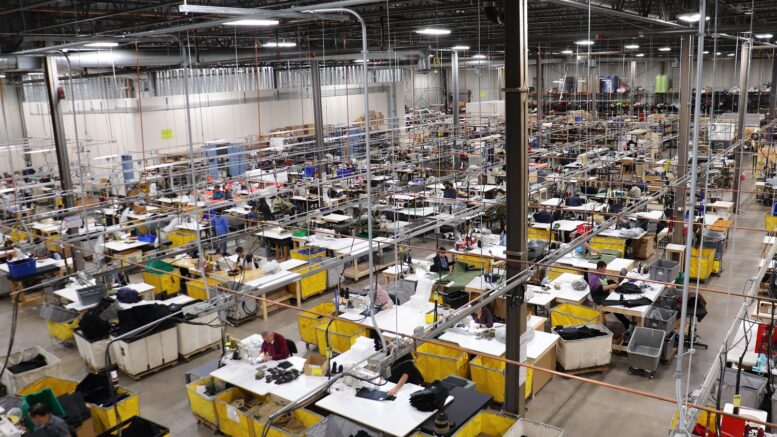When you first designed your product—a rugged backpack, a heavy-duty tool belt, or a custom toiletry bag—you probably didn’t imagine struggling to keep up with orders. But if you’re selling on Etsy, Amazon, or your own site and demand is growing fast, you’re likely asking the big question: how do I scale my sewing production without losing control or quality?
You’ve got two main options: hire a commercial seamstress (typically independent contractors) or partner with an industrial seamstress team through a professional sewing company. Each path has pros, cons, and very different implications for your business.
Let’s walk through both so you can make the right move for where you are—and where you’re going.
What Is a Independant Seamstress?
A Independent commercial seamstress is an experienced individual who produces sewn products for brands, usually on a freelance or contract basis. They often work from their own studio or even from home.
Why do small brands start here?
- Lower upfront cost.
- Easier to find locally via job boards or referrals.
- Quick turnaround when you need a small batch.
But here’s the catch: This setup is often hard to scale. We’ve seen creators hire one or two seamstresses only to hit capacity limits fast. If one person calls out sick or underperforms, your whole production line stalls.
What Is an Industrial Seamstress?
An industrial seamstress works as part of a full-service sewing operation—like our team at Fieldtex. These professionals are trained to produce large quantities at consistent speed and quality, often using industrial-grade equipment not found in home studios.
Benefits of an industrial seamstress setup:
- Large volume capacity.
- Quality control teams in place.
- Redundancy—production doesn’t stop if one person is out.
- Access to cutting, packaging, and assembly teams under one roof.
The tradeoff? Lead times are longer—usually 6–8 weeks domestically and up to 14 weeks offshore. But in return, you get predictability, professionalism, and the ability to scale big.
Comparison Table: Independant vs. Industrial Seamstress
| Feature | Independant Seamstress | Industrial Seamstress (via Factory) |
|---|---|---|
| Production Volume | Low to moderate | Moderate to high |
| Lead Time | Short (days to a week) | Longer (6–14 weeks) |
| Quality Control | You inspect each item | QC team ensures consistency |
| Cost Per Unit | Lower for very small runs | Lower for large runs |
| Risk of Delays | High (illness, personal schedule) | Low (staff redundancy) |
| Scalability | Limited | High |
| Management Effort | High (training, feedback, oversight) | Low (production is handled for you) |
Real-World Scenarios from Brands Like Yours
🧵 Tool Belt Maker Hits a Wall:
An inventor hand-sewing belts in his garage reached a breaking point. Hiring two seamstresses helped—for a while. But holiday demand exploded. Eventually, we helped him shift to an industrial setup so he could focus on product design and new sales channels.
👜 Toiletry Bag Brand Outgrows Local Help:
An Etsy seller relied on two commercial seamstresses but struggled with late deliveries and inconsistent stitching. After transitioning to our facility, her reviews improved and returns dropped by 30%.
🎣 Fly Fishing Startup Finds Focus:
A small brand making fly fishing bags outsourced to us and reinvested that time into marketing and retailer outreach. Their monthly sales doubled within six months.
Why Businesses Transition to Industrial Sewing
If you’re sewing late into the night, scrambling to inspect every unit, or worrying that one missed delivery could tank your reviews—you’re not alone. At some point, speed becomes less important than stability.
Working with a sewing company allows you to:
- Reclaim your time. Focus on growing the business, not micromanaging sewing.
- Ensure consistent quality. No more second-guessing every zipper or seam.
- Plan with confidence. Predictable lead times mean fewer backorders and better inventory management.
Our clients often say the same thing: “I wish I did this sooner.”
FAQs: What Creators Ask Us
Q: Can I still be involved in product oversight?
Absolutely. We encourage clients to approve samples, run test batches, and visit our facilities. You’re in control—we just do the heavy lifting.
Q: How do I know I’m ready to switch from a commercial seamstress to a factory?
If you’re missing deadlines, turning away orders, or burning out from managing production—it’s time.
Q: Is it expensive?
Our pricing is competitive for brands that need consistent output. Plus, we save you time (and money) by reducing mistakes and missed shipments.
Final Thoughts: Choosing Your Next Step
If you’re still building your brand and shipping a few units per week, a commercial seamstress may be the right fit. But if demand is growing—or you want it to—an industrial seamstress team is how you scale sustainably.
At Fieldtex, we’ve helped dozens of creators go from kitchen table operations to full-fledged product companies. When you’re ready to grow, we’re here to help.
Talk With Us About Scaling Your Sewing Production
Ready to stop stitching at 2am and start scaling with confidence?
Reach out today to learn how our team of industrial seamstresses, designers, and project managers can bring your product to life—at scale.

